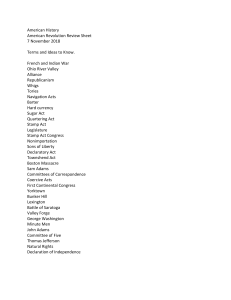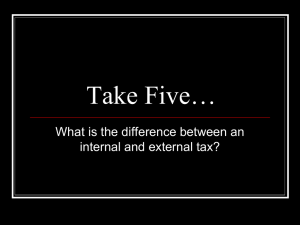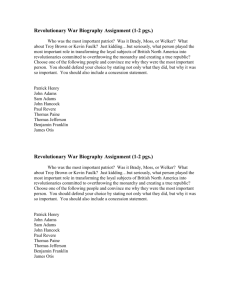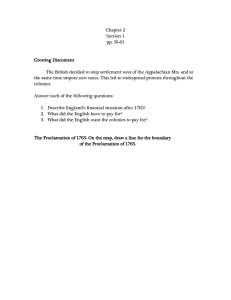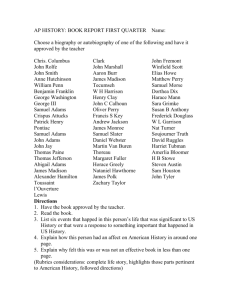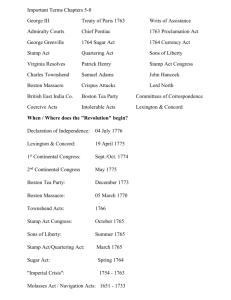Events leading up to the Revolution
advertisement
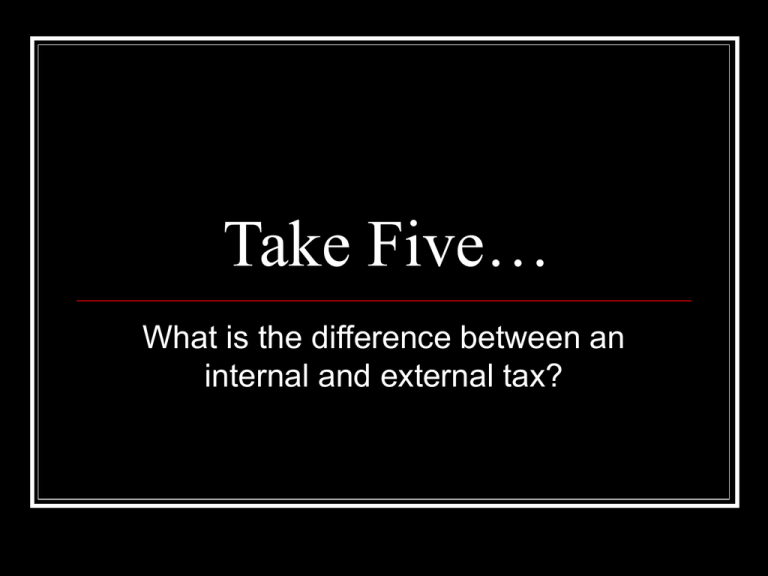
Take Five… What is the difference between an internal and external tax? Years of Tumult 1763-1770 Salutary Neglect Navigation acts, Prohibiting paper currency, Regulating trade Robert Walpole’s attitude Confusion and corruption of government Attitude of colonists Little Parliaments Little England Albany Plan Benjamin Franklin Take Five The Wars Resume Seven Years War ( French and Indian war) Conflict over the Ohio River Valley Virginia fights back Robert Dinwiddie Fort Necessity Impressments Germ warfare The “Cajuns” The Glorious Victory William Pitt General Wolfe Attacking Quebec Peace of Paris Gains of the Seven Years’ War Conflicts of interest “British Canada” Sugar islands British rule in Canada French Indians General Sir Jeffrey Amherst Pontiac’s Rebellion Proclamation Line of 1763 Map of Ohio River Valley Region The “Redcoats” in the Colonies The Quartering Act Establishing Parliamentary rule over the colonies William Pitt and the English national debt George Grenville (1763) Changing the Molasses Act American Revenue Act (Sugar Act of 1764) New England’s reaction Whigs Elected assemblies Trial by jury Boycotting imports The Currency Act (1764) Post war economic depression “Middling class” outrage Distribution of pamphlets Reduction of the tax on molasses The Stamp Act of 1765 Acts of noncompliance Vice-admiralty Courts John Dickinson Sons of Liberty Boycotts and violence Virginia resolves Patrick Henry The Stamp Act Congress James Otis Declaration of Rights and Grievances Lese-majeste The Stamp Tax The British Constitution Ideals of the Magna Carta Conflicts over representation Colonial viewpoint British viewpoint “Virtual representation” King George III King George III “Kings friends” Dismissal of Grenville Lord Rockingham (July 1765-1766) Repeal of the Stamp Act Declaratory Act Protest back at home… Lord Chatham (William Pitt) Charles Townshend (1766-1767) Townshend Duties Charles Townshend Mutiny Act (Quartering Act) 1765 Disbanding the New York assembly (army hq) Taxes on imports (external taxes) From Eng.: lead, paint, paper & tea Boycotts—”American goods” becomes fashionable Massachusetts Assembly Circular letter Lord North Repeal of the Townshend Duties Riot to Rebellion 1770-1776 The colonies in 1763 Hostilities in the colonies The problem with the Redcoats Working classes and competition The role of alcohol The Boston Massacre (March 5, 1770) British Captain Thomas Prescott “Liberty boys” Paul Revere Samuel Adams John Adams Crispus Attucks The Trial of the Century… Internal disputes The Regulators The Boston Massacre Crispus Attucks Paul Revere Samuel Adams John Adams The March toward War Leaders of the rebellion James Otis Writs of assistance Patrick Henry “Give me liberty or give me death” Samuel Adams Patrick Henry The Tea Act of 1773 The Gaspee incident (1772) East India Co. Mercy Otis Warren “The Daughters of Liberty” Boston Tea Party (Dec. 16, 1773) Thomas Hutchinson The Intolerable Acts Closing Boston ports A new governor and new policy A new government Quartering Act of 1774 Quebec Act of 1774 Turning toward revolution Committees of Correspondence Continental Congress Philadelphia The delegates The Suffolk Resolves Loyalty to the King Raising an army (the militia) “Minutemen” The Midnight Ride Paul Revere First Blows Lexington and Concord Paul Revere, William Dawes & Samuel Prescott Sniping British retreat Another intolerable act Restriction of the Grand Banks First Blows (con’t) Battle of Bunker Hill (Breed’s Hill) General Howe British victory Fort Ticonderoga Green mountain boys Ethan Allen Benedict Arnold General Sir William Howe Battle of Fort Ticonderoga Second Continental Congress Finding a General George Washington “Declaration of the Cause & Necessity of Taking Up Arms” Common Sense Thomas Paine The Constitutional Convention General George Washington Voting for Independence The Declaration of Independence The Committee Thomas Jefferson, Roger Sherman, John Adams, Robert Livingston, Benjamin Franklin The issue of slavery Signing the declaration of independence John Hancock Increasing risk What kind of men were the signers? 24 were lawyers and judges 11 were merchants 9 were farmers & large plantation owners All were well educated Who said Freedom was Free? What happened to the 56 men who signed the Declaration of Independence? 5 were captured by the British as traitors and tortured before they died 12 had their homes ransacked and burned 2 lost their sons during the war 2 had their sons captured during the war 9 fought and died in the war
